If you see what looks like white fluffy cotton on a houseplant, it’s a sure sign that you have a mealybug infestation. Getting rid of mealybugs on indoor plants can be tough but it IS possible. I came up with a proven 5 step process that’s easy and works every single time!
In this detailed guide, I will show you exactly how to eliminate them using natural treatment methods and prevent them from ever coming back.
These common pests are clever little devils – they like to hide and then come back for the sneak attack. From a distance they don’t look like bugs, so you might not even notice them until your plant is covered. First, let’s talk about what they are.
Three Natural Ways To Remove Mealy Bugs
- Dab With Rubbing Alcohol (70% Isoprophyl Alcohol) – This method works best for a mild outbreak.
- Wash With Insecticidal Soap – This will kill a large number of the adults, nymphs, and eggs.
- Spray With Neem Oil – Spray the entire plant with a neem oil solution.
What Are Mealybugs?
Mealybugs are a type of scale insect that sucks the sap out of leaves and stems leaving a powdery wax substance behind. This can result in stunted or deformed growth, yellowing of the leaves, and leaf drop.
These little white bugs usually cluster on new growth, along the veins of leaves, and at the leaf joints, but you can find them anywhere on a plant.
Mealybug damage is not as quick or as devastating as spider mites on houseplants. But if you don’t do anything, they can eventually kill your plant. Although that usually takes a long time and a very large infestation.
What Do They Look Like?
Mealybugs are tiny white bugs that can sometimes appear brown or cream colored. Their bodies are usually waxy and look like they’re covered in powder.
The first thing most people notice is the white fuzzy egg masses, rather than the insects. So at a glance it’s easy to mistake them for fungus or mildew. Gross!
Mealybugs can’t fly. So if the white bugs you see start flying around when you disturb the plant, those are whiteflies, and here’s how to get rid of them.
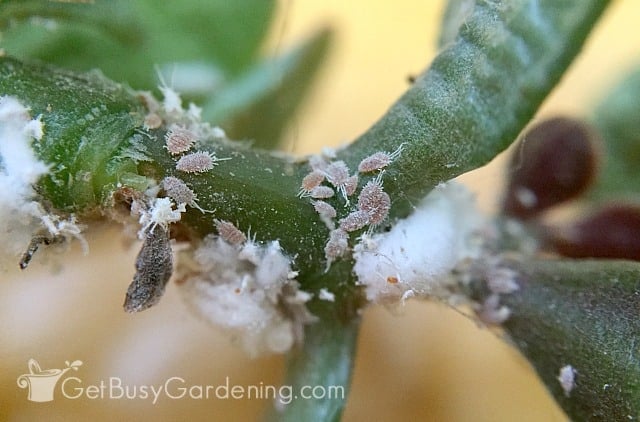
Mealybugs Life Cycle
The full life cycle a mealybug is about 7-10 weeks. It takes a week or two for the eggs to hatch into nymphs, and then another 6-9 weeks for the nymphs to mature into adults.
There can be several generations at once, and their life cycles overlap. Meaning that once they get started, their population can grow very quickly.
Since the eggs and nymphs are so small, it takes a while for the population to get large enough to see them. So most people don’t notice them until after their plant is infested.
Related Post: How To Get Rid Of Aphids On Houseplants
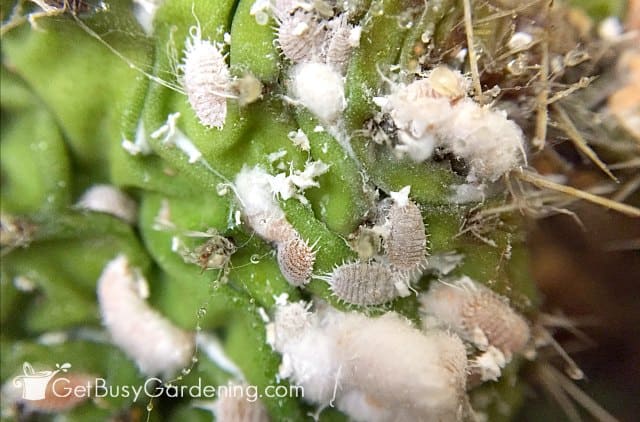
Where Do Mealybugs Come From?
Like I said before, these darn things are very sneaky. One day everything is fine, and the next day your indoor plant is covered with sticky white cotton.
This can leave you wondering what causes mealybugs in the first place? As with any other pest, they can come from anywhere. Here are the most common causes…
- Bringing home a new plant that has them.
- Using contaminated potting soil.
- Putting houseplants outside during the summer.
- Bringing fresh flowers, fruits, or vegetables in from your garden, or even the grocery store.
- Ants sometimes bring them to a plant so they can feed off of the sweet honeydew residue that mealybugs excrete.
Read more about where houseplant bugs can come from.
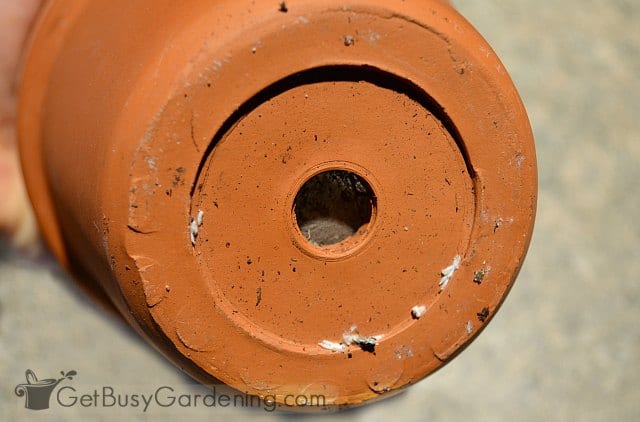
How To Get Rid Of Mealybugs Naturally
When you first spot mealybugs on any of your indoor plants, you should begin treatment immediately to get rid of them as quickly as possible. Here are some things to keep in mind.
- Quarantine time! Move the affected plant(s) to prevent the infestation from spreading to others.
- Inspect it! Check your plant from several angles because these elusive creatures like to hide. Be sure to look under every leaf, around the leaf joints, in any folds, and at the base of the stem.
- Look underneath! Make sure to also check around the edges of the pot, as well as on the bottom, as sometimes you can find them hiding there.
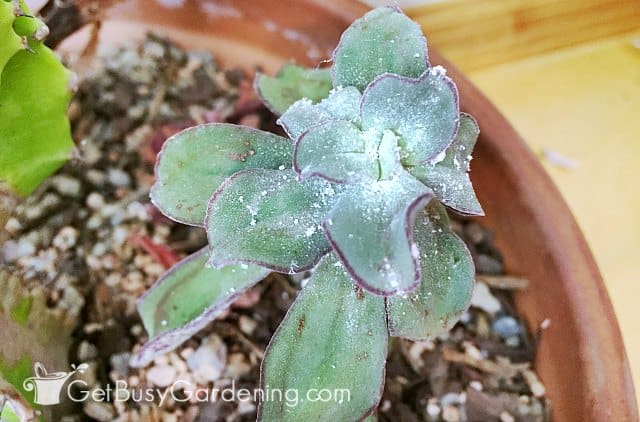
1. Dab With Rubbing Alcohol (Isoprophyl Alcohol)
One way to treat the mealybugs on your houseplants is to touch them with a cotton swab soaked in rubbing Isoprophyl alcohol. Aim for 70% alcohol to start.
The rubbing alcohol will kill the bugs immediately, but it must come in direct contact with them. So this method works well for a small outbreak, but it can be a bit tedious for a large infestation.
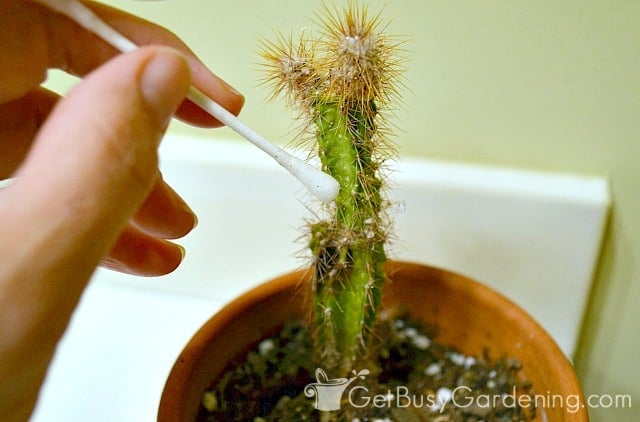
2. Wash With Insecticidal Soap
You can buy an organic insecticidal soap, or make your own. My recipe for homemade mealybug spray is 1 tsp of mild liquid soap per 1 liter of water.
If the plant is small enough, bring it to the sink or shower to wash the leaves, and then give it a good rinse. This will kill a large number of the adults, nymphs, and eggs, and help to give you the upper hand.
Insecticidal soaps don’t have any residual effect, so it’s important to continue to spray regularly until there are no more signs of bugs.
3. Spray With Neem Oil
Neem oil is a natural product that is very effective for getting rid of mealybugs on houseplants, and it has a residual effect to keep them away too.
But you still have to be persistent with your treatments, because it can take several applications to completely eliminate an infestation.
It can also take a couple of days before it starts to kick in. So be patient, and continue to reapply it every few weeks until all of the bugs are gone.
Related Post: How To Use Neem Oil On Houseplants
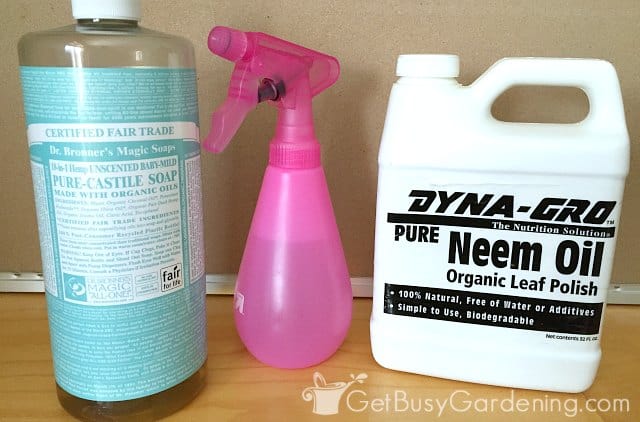
My 5 Step Process For Long-Term Mealybug Control
Mealybugs are tough to get rid of, and they can be super frustrating (I know because I’ve been there many, many times myself).
I’ve had to fight this battle a lot. So over 15 years ago, I came up with my own repeatable and proven process for long-term control that works every time. Below is my simple 5-step process that you can follow to eliminate them FOR GOOD.
Supplies Needed:
- Insecticidal soap or mild liquid soap
- Rubbing alcohol
- Cotton balls or a rag
- Neem oil
- Cotton swabs
Step 1: Wash the plant and pot – Bring the infested plant to a sink or bathtub to thoroughly wash the leaves and stems, then rinse it off. You can use insecticidal soap for this, or make your own by mixing 1 tsp of mild liquid soap with 1 liter of water.
Be sure to also wash the bottom of the pot and the drip tray. Then inspect it from top to bottom and along the soil line to see if there are any hiding mealybugs.
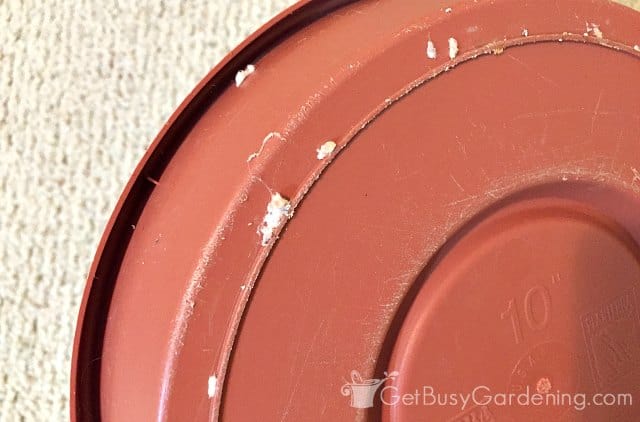
Step 2: Disinfect and inspect the area – Next, wash the area where the infested plant was sitting with soapy water. Then soak a cotton ball or rag in rubbing alcohol and use it to disinfect every nook and cranny.
If there are other houseplants nearby, inspect them thoroughly for any signs of bugs (after washing your hands of course).
Step 3: Spray neem oil – Once the leaves are dry, spray the entire plant with neem oil and move it to a location far away from all of your other indoor plants.
Step 4: Check daily – Inspect the infested plant every day for any signs of mealybugs. If you find any, use a cotton swab dipped in rubbing alcohol to kill each one.
You should also keep a close eye on any plants that were sitting near the infested one to make sure they didn’t spread. Be sure to wash your hands after touching each plant.
Step 5: Repeat – If you’re still finding mealybugs every day for a week straight, spray the plant again with neem oil. Otherwise treat it every few weeks until you no longer find any mealybugs.
Once you’re sure your plant is bug-free, it’s safe to add it back to your collection.
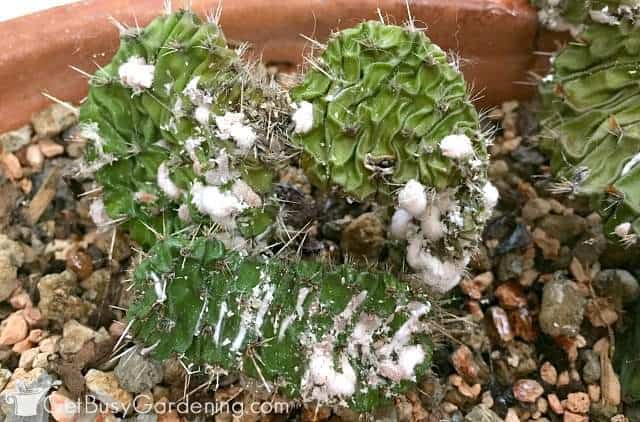
How To Prevent Mealybugs From EVER Coming Back
Most of the time mealybugs don’t appear to move, but they can crawl around and infest other houseplants in the area. The worst part is that they can live in tiny spaces and crevices for a long time without a host plant.
So just when you think you have conquered the beast, they will come out of hiding and re-infest your indoor plants when you’re not looking.
But don’t worry, there are measures you can take to prevent mealybugs from ever coming back. Here are some tips.
- If one of your plants is plagued by recurring infestations, try removing the top inch of soil. Then wash the inside rim with soapy water or disinfect it with rubbing alcohol, and add fresh potting soil.
- Thoroughly clean the area and any nearby crevices or potential hiding spots. Be sure check under the outside lip edges and the bottoms of both the pot and the tray.
- Once you have the infestation under control, move your plant to a new location to get it away from any mealybugs that might be hiding in the spot where it was sitting before.
- I know it’s tempting, but never repot an infested plant. It’s already under a lot of stress from the bugs, and the added transplant shock could end up killing it.
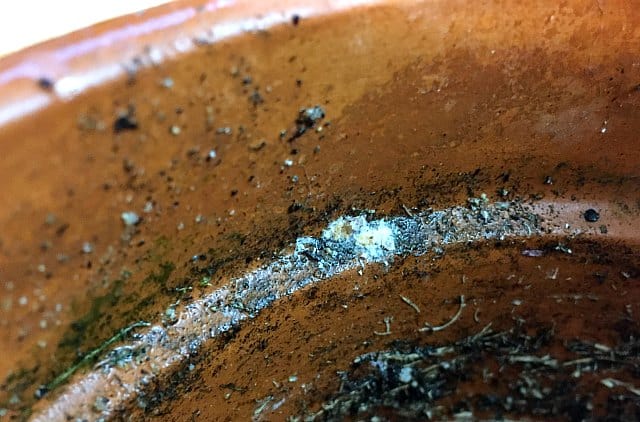
It’s hard to get rid of all of the mealybugs the first few times you try. Even if you are able to kill all of the adults, the nymphs and eggs are tiny and easy to overlook. It can be frustrating, but it’s worth it to save your favorite houseplants.
Final Tips For Treating Mealybugs On Plants
My best advice to you is be persistent. You can’t just spray a plant once, and expect the mealybugs to disappear. It will take several treatments to get rid of all of them.
It can take a few weeks, or even months to kill the entire population. So be sure to inspect your houseplant daily and kill any new ones that you see right away.
Also, always use organic products and natural methods. I don’t recommend using synthetic pesticides, because mealybugs are resistant or can build up a resistance to these chemicals.
So skip the toxic stuff and use the safer techniques that I’ve listed below. Learn more about natural houseplant pest control methods and remedies here.
Keep in mind that some types of soaps and sprays, even organic ones, can damage sensitive plants. So always test the solution on a few leaves before spraying the entire thing.
Consider Grabbing My Houseplant Pest Control Ebook!
If you are tired of constantly battling bugs on your indoor plants, then my Houseplant Pest Control eBook is for you. It will help you identify the bugs that are infesting your plants, show you exactly how to get rid of them, AND arm you with the tools you need to keep those nasty pests away FOR GOOD! Download your copy today
More About Houseplant Pest Control
- How To Get Rid Of Houseplant Bugs Naturally
- How To Debug Plants Before Bringing Them Indoors
- How To Get Rid Of Fungus Gnats In Houseplant Soil
- How To Get Rid Of Thrips On Indoor Plants
- How To Get Rid Of Scale Insects On Houseplants
How do you get rid of mealybugs on houseplants? Share your treatment tips in the comments below.
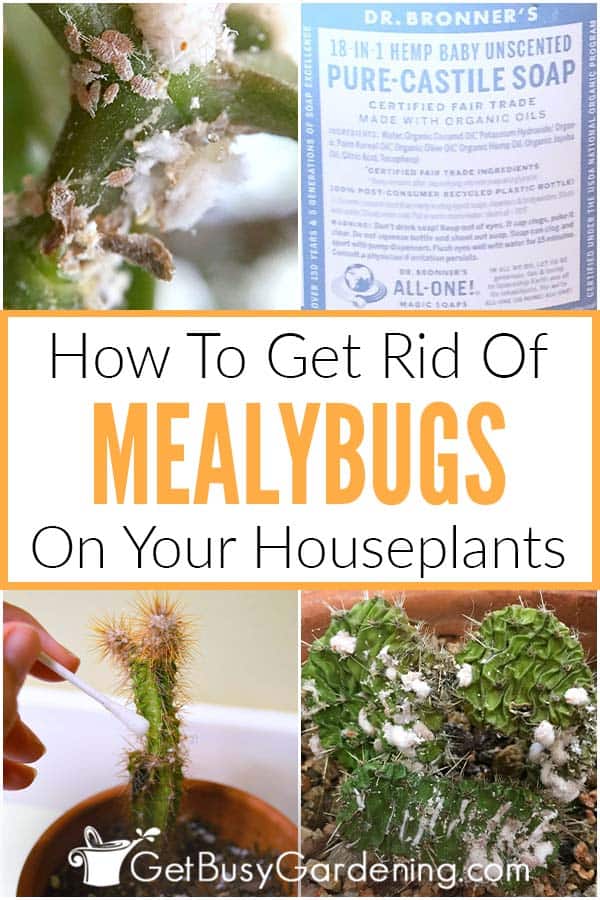
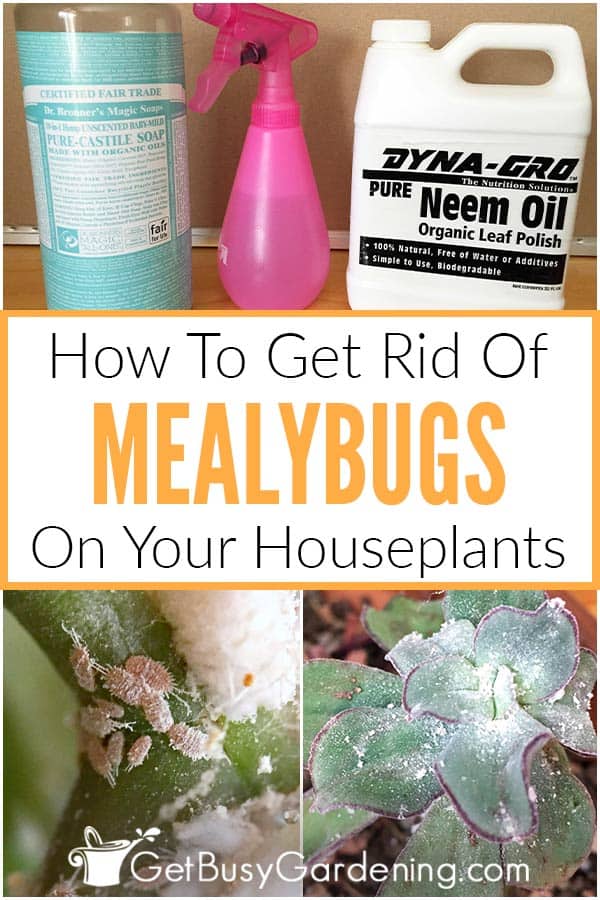
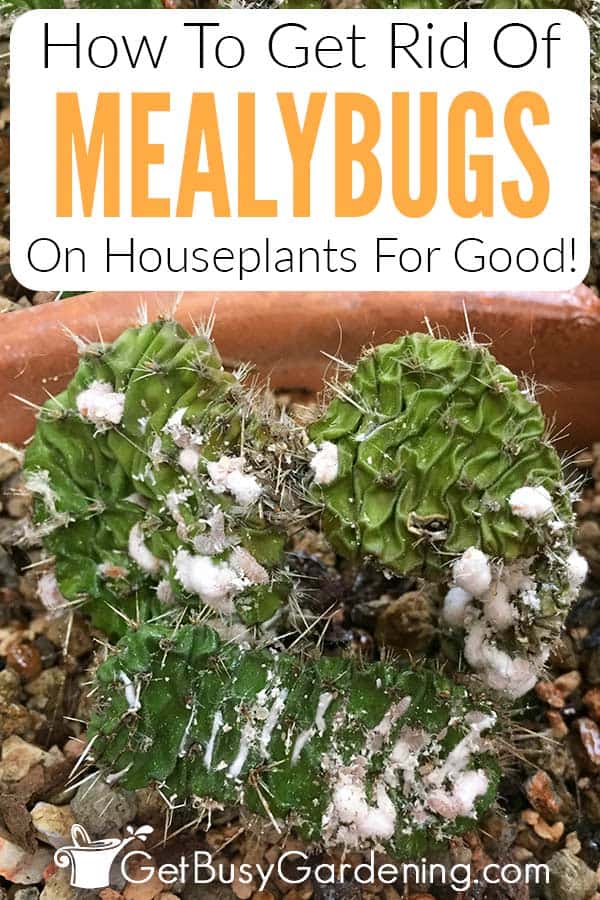
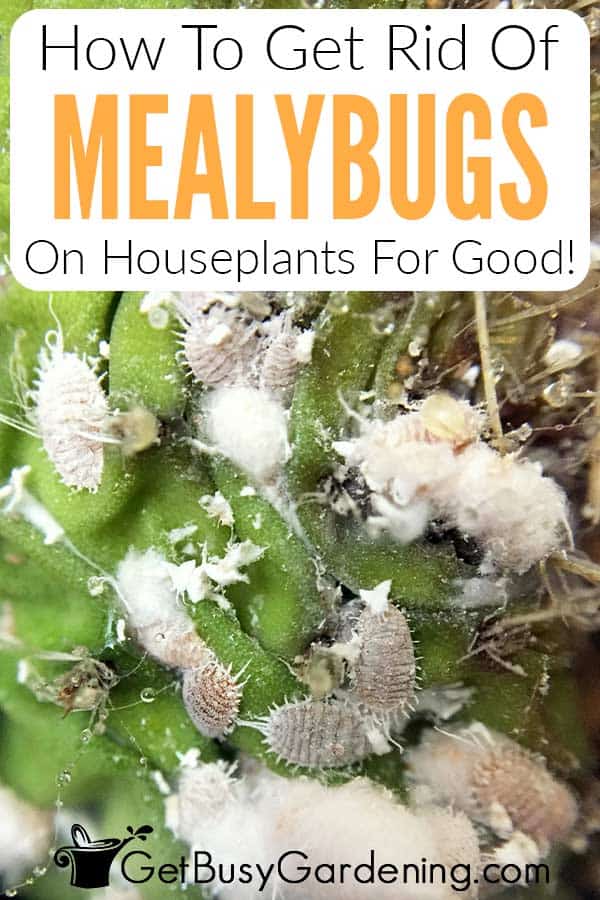
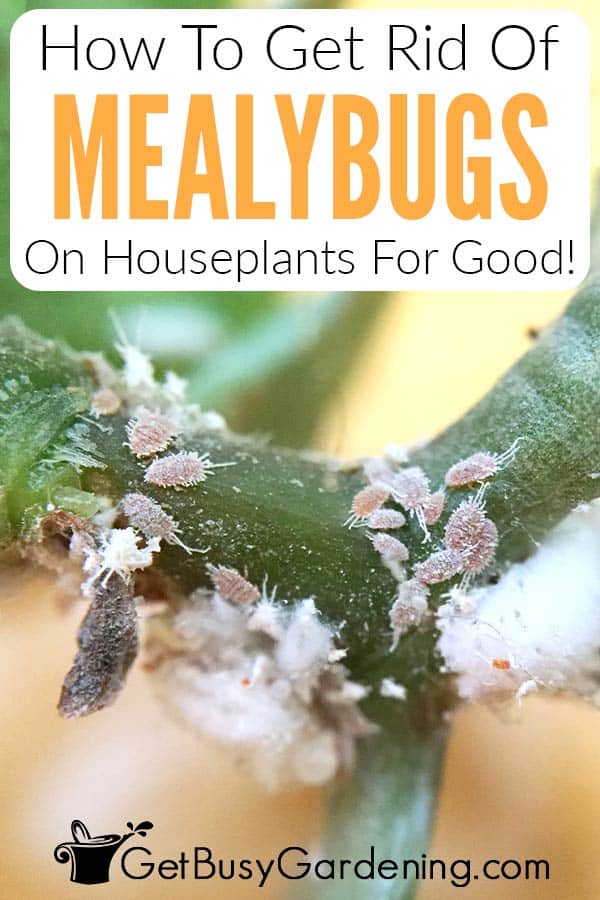
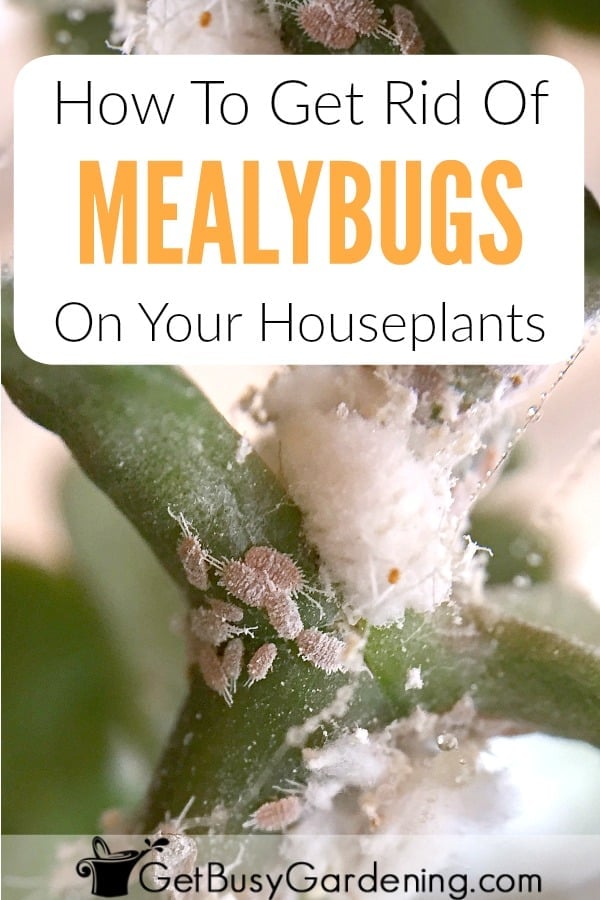
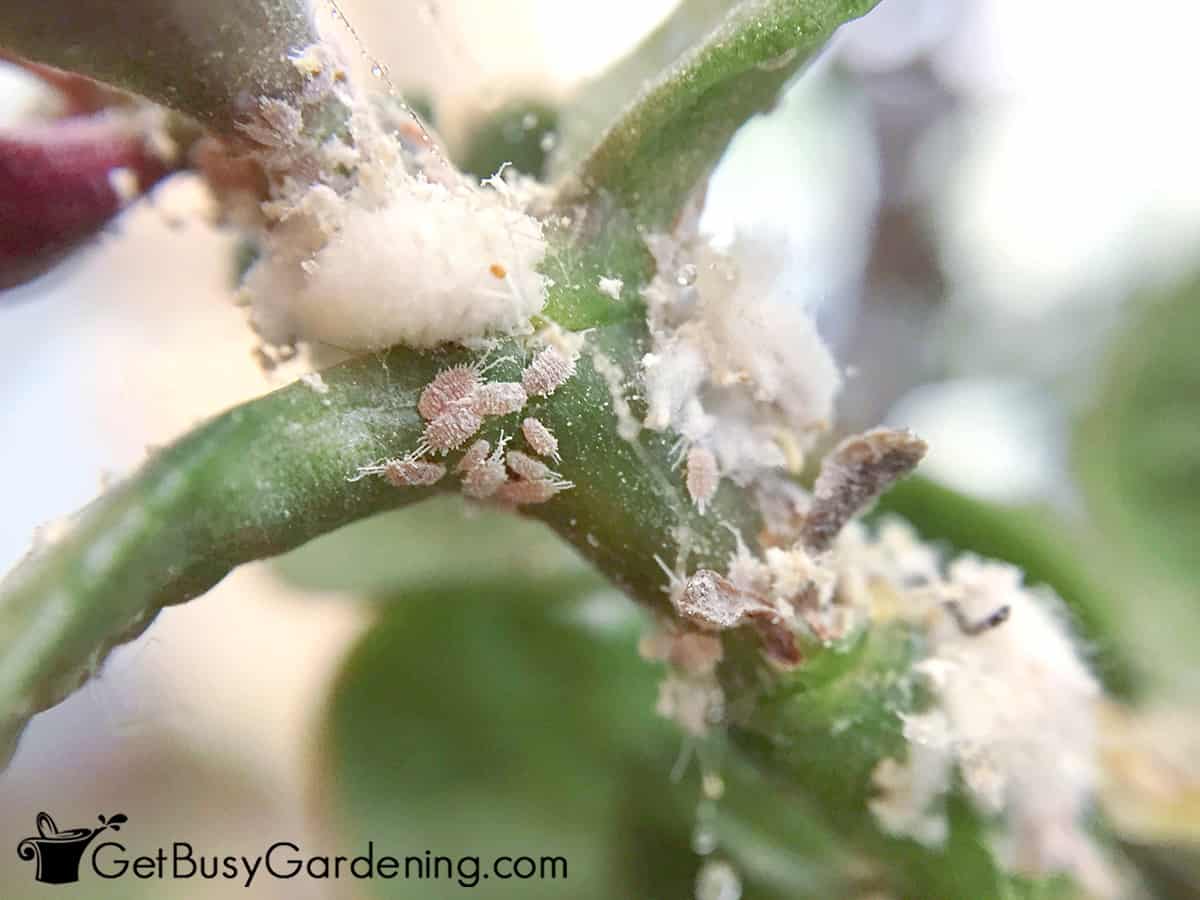

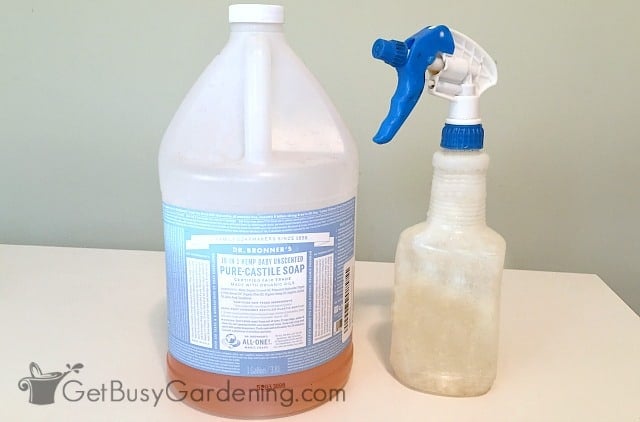



C-Green says
I live in zone 9B. I have had these beautiful mums for 4 years. Every year at this time they show the stupid mealy bugs & of course some others plants have gotten it too. It doesn’t matter what I spray them with, it’s always back: I have soaked them with neem oil, water & soap, mix of things shown in YouTube like garlic, ginger, baking soda, last year a professional in the subject that works in my community, came and spray them with the commercial spray they use. Always hopeful & always disappointed. Yesterday I made the decision of getting rid of them : ( I did as softly as I could trying not to spread it to other plants. I took out as much roots as I could. I sprayed the area with root killer. When it dried, I made a solution of water, soap, alcohol and neem oil & soaked the whole area. I’ll continue to do that every day for a week and then every other day. I think I’ ll let it rest for a week or so before I replant. Hopeful once again.
Amy Andrychowicz says
Oh no, that sounds very frustrating. One of the best ways to fight bugs in the garden (including mealybugs) is to use beneficial insects like ladybugs, praying mantis, or beneficial nematodes. I have my fingers crossed that the new plant you put in that spot won’t have any issues. Good luck!
Rhonda says
Try washing in dawn warm soapy water in sink. The water needs to be slight warmer than our skin. Then I add new soil and replant after.
Betty says
Hi, can I use seven in sevi on my infected plants? I’ve used it on my Rose’s Bushes and Tomatoe Plants many times it always takes care of the problem! Please let me know what you think? Thank’s Betty
Amy Andrychowicz says
I don’t recommend that product because it’s a synthetic chemical and not organic/natural (especially on vegetables!). Plus mealybugs can build up a resistance to chemical pesticides over time.
Ben says
My bird of paradise got infested this year with mealy bugs and it spread to my Sabel Palm. I honestly don’t see any bugs, just the chalky dust. My plants are large and go outside in the summer so I sprayed them off. But now I’m worried that the bugs are all over the ground, and could infect my entire back yard. Should I be worried? The neem oil I bought came in a spray bottle so I don’t think I need to mix it with water. Should I still add dish soap? I also was told to buy a systemic. (Bioadvanced tree and shrub) Will the systemic kill the bugs that landed in the potting soil?
Amy Andrychowicz says
You don’t have to worry that mealybugs are going to take over your entire backyard because there are natural predators outside that will feed on them and help to keep them under control. Reading the instructions on the specific product(s) that you have is the best way to make sure you’re using them correctly. I personally do not use the systemic product you’re referring to because it is a chemical and not organic.
emily lev says
My plant is fairly large and not easily transportable. I cannot put it in the sink either.
Should I leave the plant outside for a few days while treating it with the water and mild soap solution? Or do I treat the plant exactly where it is situated?
thank you!
Amy Andrychowicz says
You can skip that first step and just use a cotton swab and/or cotton ball soaked in rubbing alcohol to wipe off as many of the mealybugs that you can find. Then you can soak a rag (or also use a cotton swab/ball) in the neem oil mixture, and rub it on the leaves and stems to apply it in stead of spraying.
Pippi says
Hi, my 40 year old HUGE hoya is too big to move, but I will try. ‘she’ has moved several times with me and sometimes mistreated, but has never experienced mealybugs until now. ‘She’ is indoors in my coastal California home and is infested! Some of her ‘offspring’ are also large plants now and show signs of mealybugs. I check weekly and spray. I missed a week and now plant showing dead trails ( which I have cut off) Bugs have traveled to other hoyas, but not my other plants. I will try your suggestions this weekend, check roots etc. and hopefully I can save my 40 year old hoya. Thank you for your insight !
Amy Andrychowicz says
Oh no, so sorry to hear your plant is infested with mealybugs. If you haven’t tried treating it with neem oil yet, I would highly recommend giving it a try. Just be sure to test it on a few leaves and let it sit for a couple of days to make sure it doesn’t cause any damage before you spray the whole plant. Good luck!
Karen says
I’ve never had these before on any of my garden plants! I first noticed them on my tomatoes and now they are on my hibiscus plants. How often can you spray the neem oil? So happy I found your site.
Amy Andrychowicz says
You can apply it every few weeks until you don’t see anymore bugs, here’s more info about it. However, for a mealybug infestation in the garden, I highly recommend enlisting beneficial predatory insects to help maintain a healthy, pest-free garden long term. You can apply beneficial nematodes and release ladybugs as a good first step, and get on a schedule to apply/release them every season. Here are more tips for how to maintain a balanced and healthy garden as a natural form of pest control.
Jojo says
Just wanted to say thanks! I made up some spray with Castile soap and neem oil and it actually works fantastic! I have a lemon tree and orange tree that have had mealybugs for 2 years since I bought them. I gave been battling with alcohol and washing up liquid soray fir 2 years. It kept them down but they cane back and the alcohol dried up the leaves and they dropped off on the orange plant. I was going to give up this year but came across this and they have gone within 3 days of spraying! Great stuff!
Amy Andrychowicz says
You’re welcome! So happy to hear the spray worked for you. Keep a close eye on your plants over the next several months because mealybugs don’t usually go away completely with just one treatment. You may have to spray it a few times to eliminate them for good.
Ta'Myia says
I’ll be trying your tips tomorrow, wish me luck. My flowers I grew are very important to me because I started after my doctor suggested it to keep my mind off of things. I was fighting addiction, and my plants have been my get away while staying sober so I definitely don’t want to lose my marigolds, bachelor button, morning glories, dragon flowers, pink mandevilla, zianna, or any other of my babies I’ve works SO hard on 🙁 I sprayed pesticides (3 in 1 organic) and saw a large number of them leave my marigolds but then noticed one on my bachelor button seedlings. I have a big flower party going on on my porch so I have my work cut out for me tomorrow after work haha. THANKS again and hugs from Alabama!
Amy Andrychowicz says
Good luck!! It can be a lot of work getting mealybugs under control when you have a large collection of plants, but definitely worth it to save all of your babies! Keep up on treating them, and the mealybugs will eventually be gone for good.
Jeremy says
These instructions are for indoor plants. What do you recommend for mealybugs that are infesting my backyard? There are a trio of tall trees of the same species along my fence that regularly get these large puffball mealybug colonies at the ends of each branch where it forms seeds, and I see the adult mealybugs hiding on the underside of most of the nearby leaves. They don’t seem to harm the trees, but there are possibly hundreds of these white puff balls, many too high to reach, and I think the wind is blowing them all across my yard and infecting some, but not all of the potted succulent plants. So no matter how much I kill them on the potted plants, they keep spreading throughout the yard. There’s especially one particular bush that’s just covered with them, and wiping each leaf with a cotton swab is not an option.
Amy Andrychowicz says
Yuck, that sounds terrible! I would definitely try introducing some beneficial insects (like releasing ladybugs, lacewings, or beneficial nematodes) in your yard to help control the mealybug population for a long-term solution. For the short term, the best things to do are to spray them with a strong stream from the garden hose to dislodge them, and/or spray them with soapy water to kill them. For an infestation that large, it’s going to take time and diligence to get them under control, so be persistent.
Jojo says
My citrus trees come inside in winter but are outdoors in summer. I have used the neem oil and Castile soap spray outside and it has worked for my mealybug problem
Randy says
When I bring home a new plant I always dust them with some diatomaceous earth. Especially around the base and dirt area. On my regular houseplants I dust the dirt again after a few waterings. This seems to keep the population of mealies down pretty well.
Krisan says
Can I treat the dirt that my plants (that were all so infested they died) were once in? So I can reuse it, or must I start over? All my plants are dead now because of those stupid little bugs!! I’m so frustrated, I had beautiful mature plants that seemingly over night were gone.
Amy Andrychowicz says
Definitely start with fresh soil. You never want to reuse it, especially from a plant with a pest infestation like mealybugs. Otherwise, they will almost certainly infest your new plant as well. I also recommend thoroughly washing and disinfecting the pot, tray, and also the surrounding area before placing your new plant(s) there.
dakota says
Microwave it
meryl says
I often microwave the soil, especially orchid bark.
Vanessa Wilson says
Thank you this article has been very helpful ☺🌟
Amy Andrychowicz says
You’re welcome, glad you found it helpful! 🙂
Kitty Riggs says
Not only do we have a Mealy Bug plant infestation, but the have also infested our entire house. We just can’t seem to get control of them. Can’t spray Neem Oil in the house!
Anyone else have this problem?
Amy Andrychowicz says
Yes, mealybugs can live without a host plant for a while, and that’s part of what makes them so difficult to get rid of. I’ve never heard of them infesting a whole house though, that’s weird. You can spry neem oil inside the house, but it will only work on plants (the bugs have to eat it in order to die). For the ones that aren’t on a plant, I would use rubbing alcohol or soapy water to thoroughly wash the area. That will be the best way to kill any mealybugs you find that aren’t on a plant.
Erica Gonzales says
Hey!! I just ordered and received the Dr Brunner’s baby soap and exact Neem oil you recommended! Per liter of water what would be the best measurements? 1 tsp each? What do you recommend? Great article thanks!!
Amy Andrychowicz says
Awesome! Mix 1 1/2 teaspoons neem oil concentrate with 1 teaspoon mild liquid soap and
1 liter of water. You can find the exact instructions for how to use it, along with my detailed recipe here… How To Use Neem Oil Insecticide On Houseplants.
Laura says
What do you suggest we do with the stuff that looks like cotton wool? Should I try and clean it off somehow? Or will it go in its own as the bugs die?
Amy Andrychowicz says
Yes, clean off the stuff that looks like cotton. In doing so, you will also kill many of the mealybugs and their eggs. Eventually it will go away once you eliminate the bugs.
Barb says
Never give up. I cut my plant back to almost nothing – it is growing again – but of course the mealy bugs are also growing. But I will keep fighting the battle. I have almost thrown in the towel on this plant a few times but it’s special to me as I brought it from another city and I want to save it. I will not be defeated by these things. They have infested my other succulents but they are a lot bigger and hardier so I’m not as worried about them. NEVER GIVE UP!!
Amy Andrychowicz says
Thanks for sharing your story and encouragement. I hope you’ll be successful at getting rid of those nasty mealybugs soon!
Rhonda says
These evil little devils are the worst! I’ve been fighting a war with mealy bugs on my special rare plant that is 30 years old. I’m going to try all your steps. The one thing I haven’t done is spray Neem Oil every 2 weeks and keep fighting this war. A WAR it is! I’m exhausted from trying 🤦🏼♀️
Amy Andrychowicz says
Oh no, so sorry to hear that your rare plant has mealybugs. That is super frustrating! Yes, definitely try to the neem oil. That has worked like magic for me to get rid of these persistent pests on several of my plants. Good luck, and don’t give up. You will win this battle! 🙂
Rhonda Ward says
I would like to ask a question. I feel like an FBI AGENT with these mealy bugs. With certain plants that have grooves in the branch that extends forward and bark for a covering. I have spent at least over an hour with a tips n alcohol n then neem oil. But…. the bugs can hide under the bark. There must be a systemic ‘something’ that can travel through stems to leaves through bark. Any thoughts at all on that subject? Thank you!
Amy Andrychowicz says
Spraying neem oil on the stem where you see the mealybugs should work, it just takes some time for them to feed on it and die. So you have to be persistent and patient. Each time you spray the plant, make sure you cover the entire thing – stem leaves and all. You can also try using neem oil as a systemic pesticide, just pour it over the soil as well as spraying it on the plant. Be careful not to overwater in the process though. Here’s a post that will give you more details… How To Use Neem Oil Insecticide On Plants.